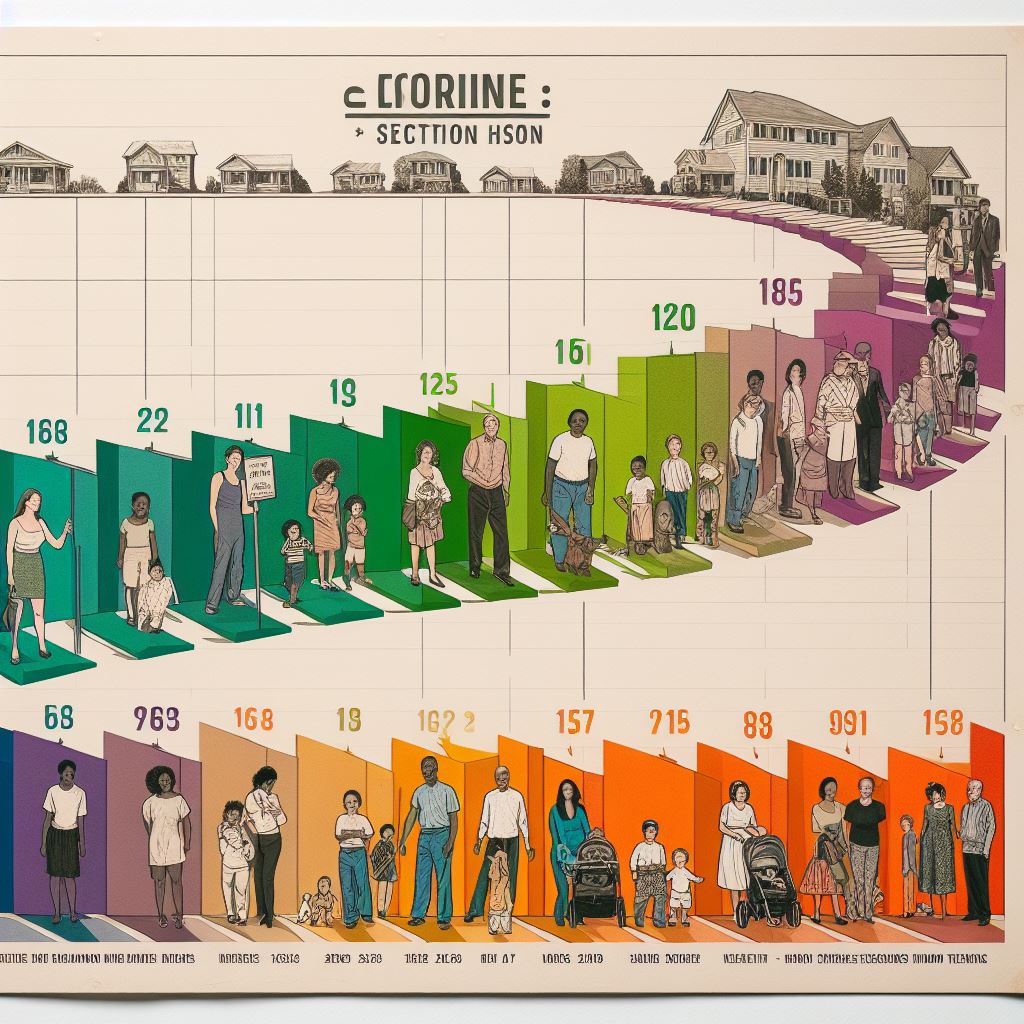Unraveling the History of Section 8 Housing Income Requirements

Want to dig deeper into the complex world of Section 8 housing income requirements? Get ready to unravel the intricate history behind this crucial policy.
From its birth to the evolution of income guidelines, this article will delve into the impact of policy changes and the challenges faced by eligible applicants.
With an analytical and objective approach, we’ll also explore the future outlook and potential reforms.
So, buckle up and prepare for an enlightening journey through the past and future of Section 8 housing.
Key Takeaways
- Section 8 was established through the Housing Act of 1937 and the Wagner-Steagall Act, with the modern program created in the Housing and Community Development Act of 1974.
- The program introduced housing vouchers for low-income individuals and families, with income requirements adjusted periodically based on factors like inflation and government priorities.
- Income guidelines initially based on federal poverty level (FPL) and later based on area median income (AMI), becoming more flexible based on family size and composition.
- Policy changes can impact eligibility criteria, accessibility of Section 8 housing, and waiting lists for assistance, while eligible applicants face challenges such as limited funding, lengthy waiting lists, discrimination by landlords, and the struggle to find affordable and safe housing while waiting for assistance. Potential reforms include increasing funding, streamlining the application process, expanding availability of affordable housing, and ongoing advocacy and policy changes.
The Birth of Section 8
When Section 8 was first established, you may wonder how it came into existence. The birth of Section 8 can be traced back to the Housing Act of 1937, also known as the Wagner-Steagall Act. This act was enacted during the Great Depression to address the dire housing conditions faced by low-income families. It provided federal funding to local housing authorities to construct and manage affordable housing units.
However, it wasn’t until the Housing and Community Development Act of 1974 that the modern Section 8 program as we know it today was created. This act introduced the concept of housing vouchers, allowing eligible low-income individuals and families to choose their own housing in the private rental market. The program aimed to provide more flexibility and choice for recipients while also promoting fair housing practices.
Over the years, Section 8 has undergone various changes and updates to improve its effectiveness and address the evolving needs of low-income households. Today, it continues to play a crucial role in providing safe and affordable housing options for millions of Americans.
Evolution of Income Guidelines
As you delve into the evolution of Section 8 housing, it’s important to understand how the income guidelines have undergone significant changes over time. The income requirements for Section 8 housing have been adjusted periodically to reflect changes in the cost of living and to ensure that the program is targeting those who need it most. These changes have been influenced by various factors, such as inflation, changes in poverty thresholds, and shifts in government priorities.
Initially, the income guidelines were based on the federal poverty level (FPL). However, as the cost of living increased, it became clear that the FPL alone wasn’t sufficient to accurately determine eligibility for Section 8 housing. In response, the Department of Housing and Urban Development (HUD) began using the area median income (AMI) as a benchmark for determining eligibility. The AMI takes into account the local cost of living and provides a more accurate representation of a household’s income in relation to its community.
Over time, the income guidelines have also become more flexible, allowing for adjustments based on family size and composition. This ensures that families with higher expenses, such as childcare or medical costs, aren’t unfairly excluded from the program.
Impact of Policy Changes
To understand the impact of policy changes on Section 8 housing income requirements, consider how these adjustments have affected eligibility and accessibility for low-income households.
Over the years, policy changes have influenced the income limits and guidelines for Section 8 housing. These changes have had both positive and negative effects on low-income households.
One of the main impacts of policy changes is the fluctuation in eligibility criteria. When income requirements are adjusted, the number of households that qualify for Section 8 housing can either increase or decrease. This can result in a higher demand for affordable housing or a decrease in available units for low-income families.
Policy changes also affect the accessibility of Section 8 housing for low-income households. Adjustments in income limits can determine whether certain households are eligible for assistance or not. This can have significant implications for families struggling to find affordable housing options. Additionally, policy changes can also affect the waiting lists for Section 8 housing, leading to longer wait times for applicants.
Challenges Faced by Eligible Applicants
Experiencing the impact of policy changes, eligible applicants for Section 8 housing face various challenges in accessing affordable and safe housing options. These challenges stem from a combination of factors, including limited funding, long waiting lists, and discrimination.
The first major challenge is the lack of funding for Section 8 housing. The demand for affordable housing far exceeds the available resources, leading to funding shortages and a limited number of vouchers being issued. As a result, eligible applicants often have to wait for extended periods before receiving assistance.
Another challenge is the lengthy waiting lists. Due to the high demand, waiting lists for Section 8 housing can be years long. This leaves many eligible applicants in precarious living situations, struggling to find affordable and safe housing while they wait for assistance.
Lastly, discrimination plays a significant role in the challenges faced by eligible applicants. Landlords may refuse to accept Section 8 vouchers or discriminate against applicants based on factors like race, disability, or family status, making it even more difficult for individuals and families to secure suitable housing.
These challenges highlight the need for continued advocacy and policy changes to improve access to affordable and safe housing for eligible Section 8 applicants.
Future Outlook and Potential Reforms
You can expect potential reforms and a positive future outlook for Section 8 housing.
As the demand for affordable housing continues to grow, policymakers and housing advocates are actively working towards improving the Section 8 program to better meet the needs of eligible applicants.
One potential reform that has gained traction is increasing funding for the program. By allocating more resources, the program can serve a greater number of low-income individuals and families, reducing the current waitlists and providing more timely assistance.
Additionally, there are efforts to streamline the application process and make it more accessible. This includes simplifying the documentation requirements and implementing online application systems to make it easier for applicants to submit their paperwork.
Another area of potential reform is expanding the geographic availability of affordable housing. By encouraging the development of affordable housing in more neighborhoods, Section 8 recipients can have greater choice and access to opportunities.
Frequently Asked Questions
How Does Section 8 Housing Differ From Other Affordable Housing Programs?
Section 8 housing differs from other affordable housing programs by providing rental assistance to low-income individuals and families. It aims to bridge the gap between the cost of housing and what individuals can afford to pay.
What Are the Main Factors That Determine Eligibility for Section 8 Housing Assistance?
To determine if you’re eligible for Section 8 housing assistance, factors such as your income, family size, and citizenship status are considered. These criteria help ensure that those in need receive the support they require.
How Have Income Guidelines for Section 8 Housing Changed Over Time?
Over time, income guidelines for Section 8 housing have changed to reflect economic conditions and the needs of low-income individuals. These changes have impacted eligibility and allowed more individuals to access affordable housing.
Are There Any Specific Demographic Groups That Are Disproportionately Affected by the Income Requirements of Section 8 Housing?
Demographic groups disproportionately affected by Section 8 housing income requirements include low-income families, minorities, and individuals with disabilities. These requirements can perpetuate housing inequality and limit access to affordable housing options for these vulnerable populations.
What Are Some Potential Reforms or Policy Changes That Could Address the Challenges Faced by Eligible Section 8 Applicants?
To address the challenges faced by eligible section 8 applicants, potential reforms and policy changes could include increasing funding for the program, streamlining the application process, and implementing measures to prevent discrimination and ensure fair access to housing.



